Detailed Business Plan: Launching Sustainable Residential Homes (UK)
VerifiedAdded on 2023/01/17
|9
|1969
|95
Project
AI Summary
This business plan outlines the strategy for a construction company, Skanska, to launch sustainable residential homes in the UK. The plan encompasses various critical elements, including an executive summary, introduction, organizational description, product and service details, market opportunity analysis, marketing strategies, operational plans, and management structures. It emphasizes the growing demand for green construction practices and the organization's focus on sustainable technologies to meet consumer needs and environmental regulations. The plan addresses market analysis using Porter's Five Forces, details Skanska's marketing and operational approaches, and discusses the importance of employee motivation, stakeholder involvement, and continuous improvement through training and performance measurement. The conclusion highlights the high potential for success while acknowledging the need for continuous adaptation and improvement to address competitive pressures and operational challenges. The plan is a comprehensive guide for the successful execution of the business idea, aiming to achieve desired profits in the construction industry.

BUSINESS PLAN LINKED
TO YOUR AREA OF
STUDY (ENGINEERING)
TO YOUR AREA OF
STUDY (ENGINEERING)
Paraphrase This Document
Need a fresh take? Get an instant paraphrase of this document with our AI Paraphraser
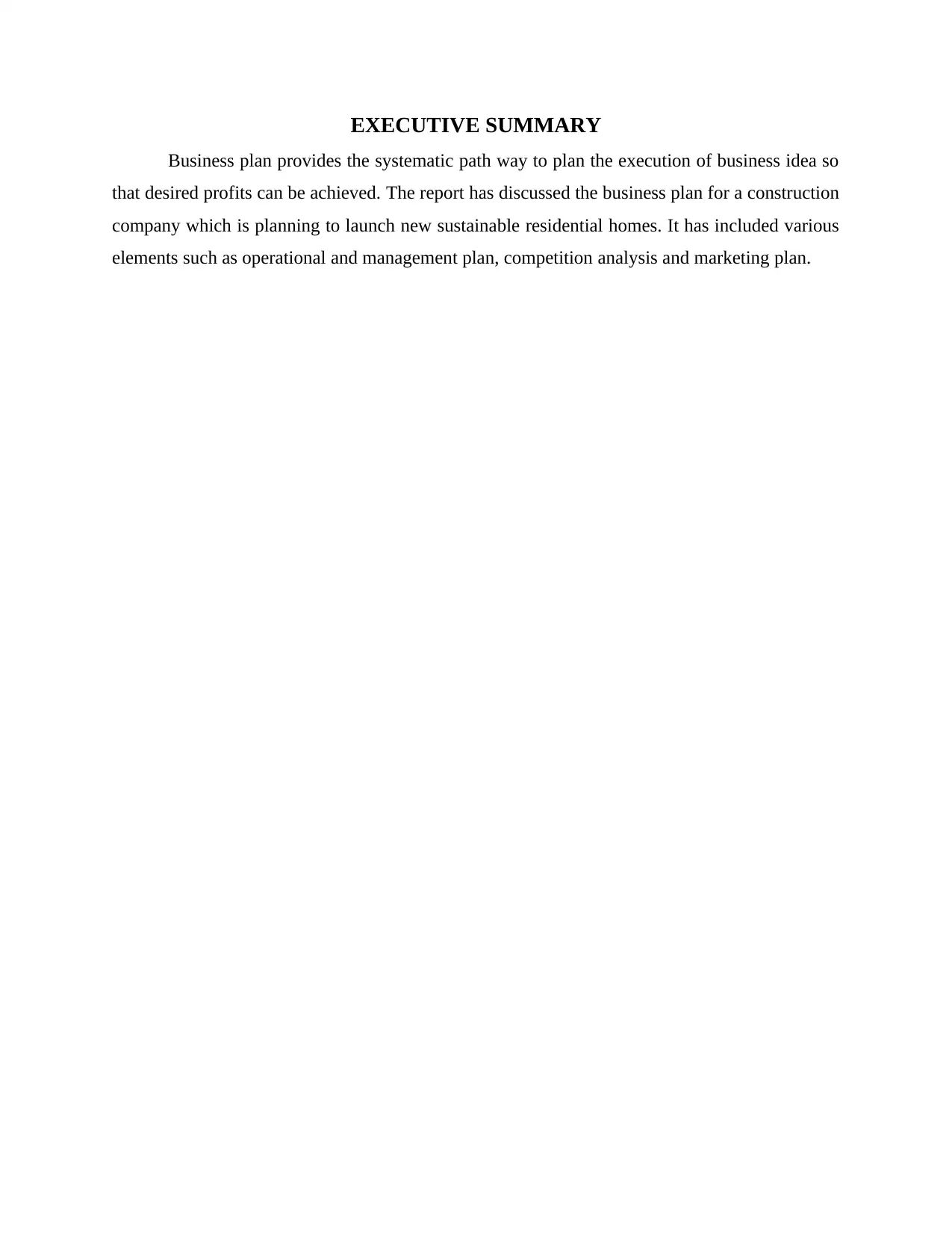
EXECUTIVE SUMMARY
Business plan provides the systematic path way to plan the execution of business idea so
that desired profits can be achieved. The report has discussed the business plan for a construction
company which is planning to launch new sustainable residential homes. It has included various
elements such as operational and management plan, competition analysis and marketing plan.
Business plan provides the systematic path way to plan the execution of business idea so
that desired profits can be achieved. The report has discussed the business plan for a construction
company which is planning to launch new sustainable residential homes. It has included various
elements such as operational and management plan, competition analysis and marketing plan.
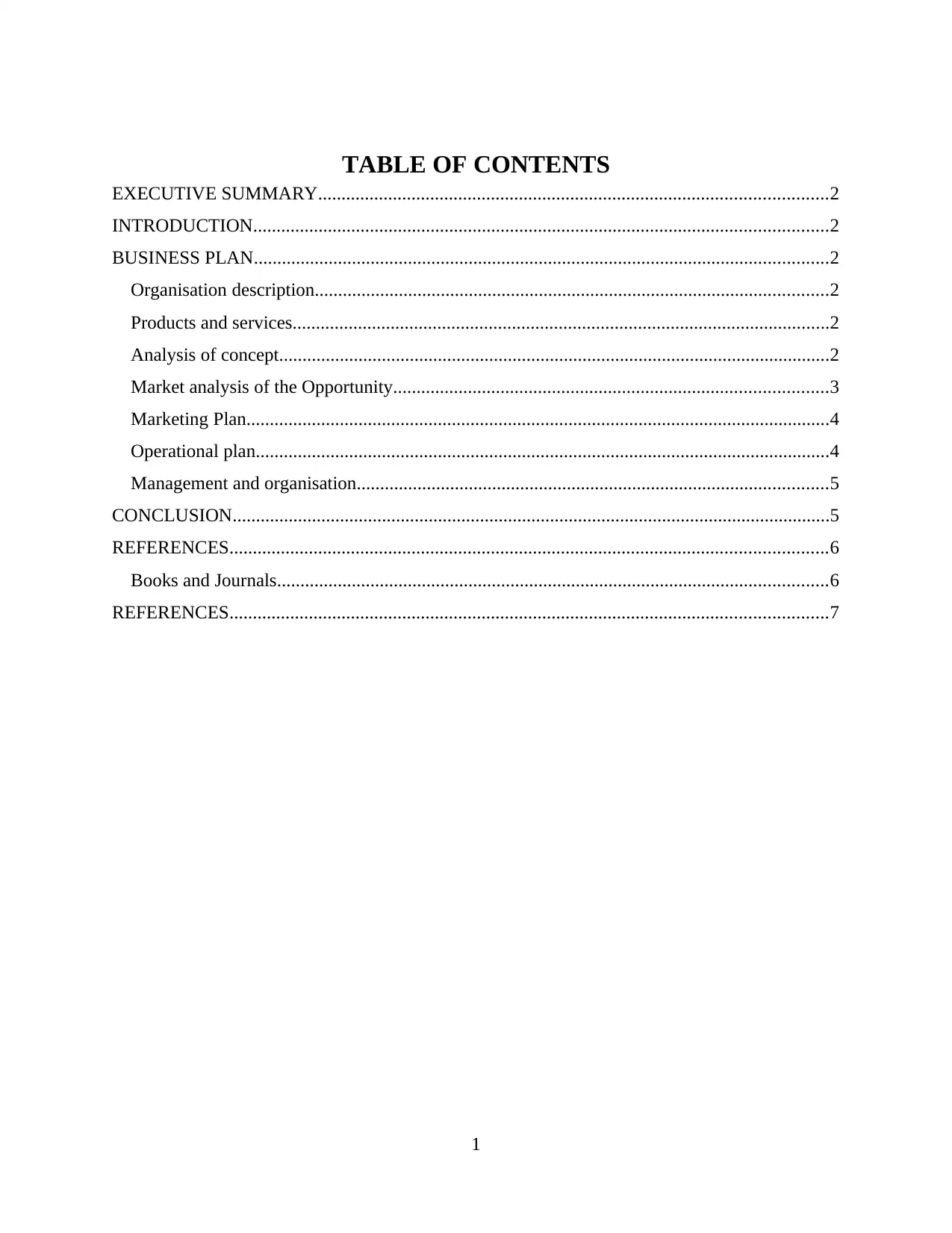
TABLE OF CONTENTS
EXECUTIVE SUMMARY.............................................................................................................2
INTRODUCTION...........................................................................................................................2
BUSINESS PLAN...........................................................................................................................2
Organisation description..............................................................................................................2
Products and services...................................................................................................................2
Analysis of concept......................................................................................................................2
Market analysis of the Opportunity.............................................................................................3
Marketing Plan.............................................................................................................................4
Operational plan...........................................................................................................................4
Management and organisation.....................................................................................................5
CONCLUSION................................................................................................................................5
REFERENCES................................................................................................................................6
Books and Journals......................................................................................................................6
REFERENCES................................................................................................................................7
1
EXECUTIVE SUMMARY.............................................................................................................2
INTRODUCTION...........................................................................................................................2
BUSINESS PLAN...........................................................................................................................2
Organisation description..............................................................................................................2
Products and services...................................................................................................................2
Analysis of concept......................................................................................................................2
Market analysis of the Opportunity.............................................................................................3
Marketing Plan.............................................................................................................................4
Operational plan...........................................................................................................................4
Management and organisation.....................................................................................................5
CONCLUSION................................................................................................................................5
REFERENCES................................................................................................................................6
Books and Journals......................................................................................................................6
REFERENCES................................................................................................................................7
1
⊘ This is a preview!⊘
Do you want full access?
Subscribe today to unlock all pages.

Trusted by 1+ million students worldwide
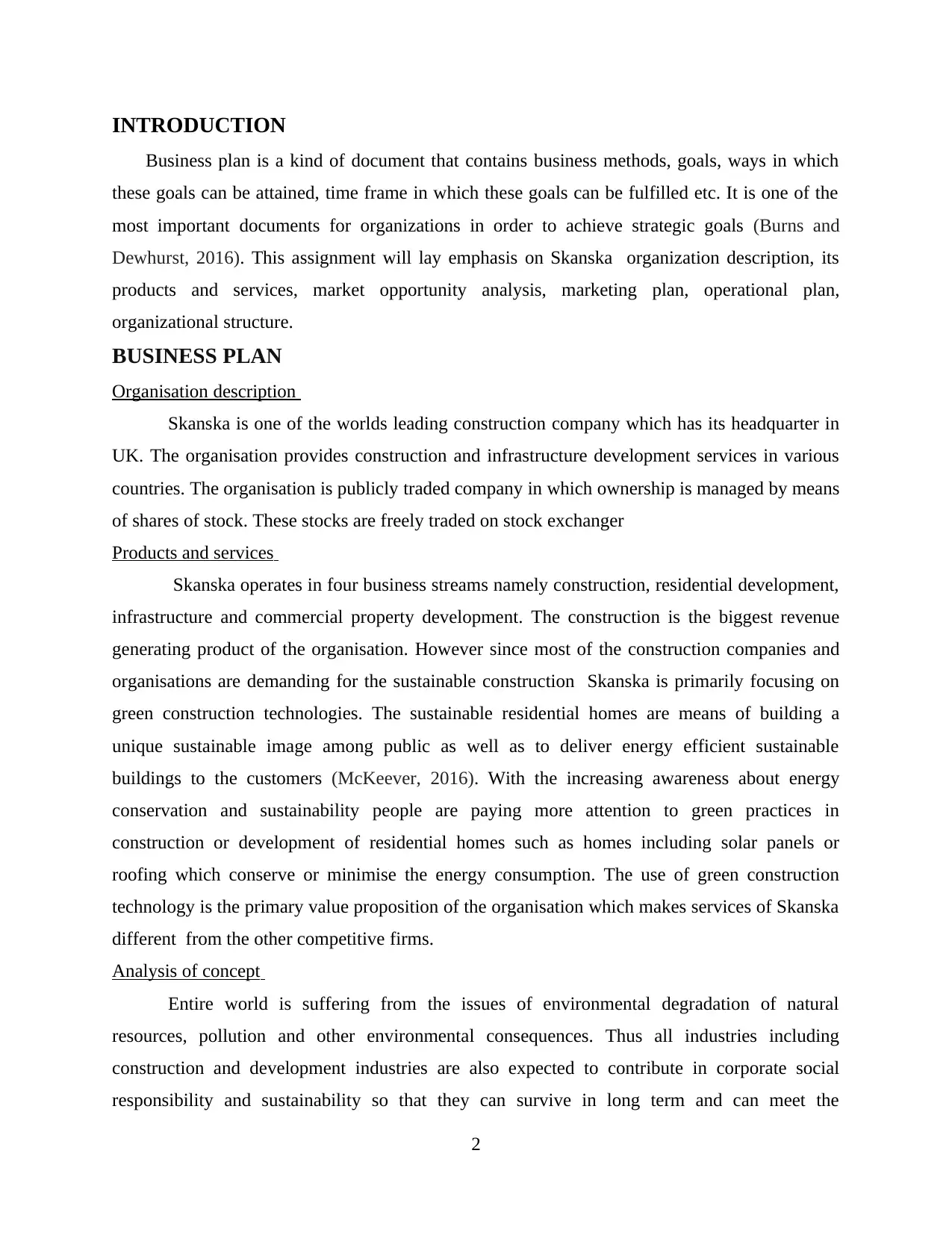
INTRODUCTION
Business plan is a kind of document that contains business methods, goals, ways in which
these goals can be attained, time frame in which these goals can be fulfilled etc. It is one of the
most important documents for organizations in order to achieve strategic goals (Burns and
Dewhurst, 2016). This assignment will lay emphasis on Skanska organization description, its
products and services, market opportunity analysis, marketing plan, operational plan,
organizational structure.
BUSINESS PLAN
Organisation description
Skanska is one of the worlds leading construction company which has its headquarter in
UK. The organisation provides construction and infrastructure development services in various
countries. The organisation is publicly traded company in which ownership is managed by means
of shares of stock. These stocks are freely traded on stock exchanger
Products and services
Skanska operates in four business streams namely construction, residential development,
infrastructure and commercial property development. The construction is the biggest revenue
generating product of the organisation. However since most of the construction companies and
organisations are demanding for the sustainable construction Skanska is primarily focusing on
green construction technologies. The sustainable residential homes are means of building a
unique sustainable image among public as well as to deliver energy efficient sustainable
buildings to the customers (McKeever, 2016). With the increasing awareness about energy
conservation and sustainability people are paying more attention to green practices in
construction or development of residential homes such as homes including solar panels or
roofing which conserve or minimise the energy consumption. The use of green construction
technology is the primary value proposition of the organisation which makes services of Skanska
different from the other competitive firms.
Analysis of concept
Entire world is suffering from the issues of environmental degradation of natural
resources, pollution and other environmental consequences. Thus all industries including
construction and development industries are also expected to contribute in corporate social
responsibility and sustainability so that they can survive in long term and can meet the
2
Business plan is a kind of document that contains business methods, goals, ways in which
these goals can be attained, time frame in which these goals can be fulfilled etc. It is one of the
most important documents for organizations in order to achieve strategic goals (Burns and
Dewhurst, 2016). This assignment will lay emphasis on Skanska organization description, its
products and services, market opportunity analysis, marketing plan, operational plan,
organizational structure.
BUSINESS PLAN
Organisation description
Skanska is one of the worlds leading construction company which has its headquarter in
UK. The organisation provides construction and infrastructure development services in various
countries. The organisation is publicly traded company in which ownership is managed by means
of shares of stock. These stocks are freely traded on stock exchanger
Products and services
Skanska operates in four business streams namely construction, residential development,
infrastructure and commercial property development. The construction is the biggest revenue
generating product of the organisation. However since most of the construction companies and
organisations are demanding for the sustainable construction Skanska is primarily focusing on
green construction technologies. The sustainable residential homes are means of building a
unique sustainable image among public as well as to deliver energy efficient sustainable
buildings to the customers (McKeever, 2016). With the increasing awareness about energy
conservation and sustainability people are paying more attention to green practices in
construction or development of residential homes such as homes including solar panels or
roofing which conserve or minimise the energy consumption. The use of green construction
technology is the primary value proposition of the organisation which makes services of Skanska
different from the other competitive firms.
Analysis of concept
Entire world is suffering from the issues of environmental degradation of natural
resources, pollution and other environmental consequences. Thus all industries including
construction and development industries are also expected to contribute in corporate social
responsibility and sustainability so that they can survive in long term and can meet the
2
Paraphrase This Document
Need a fresh take? Get an instant paraphrase of this document with our AI Paraphraser
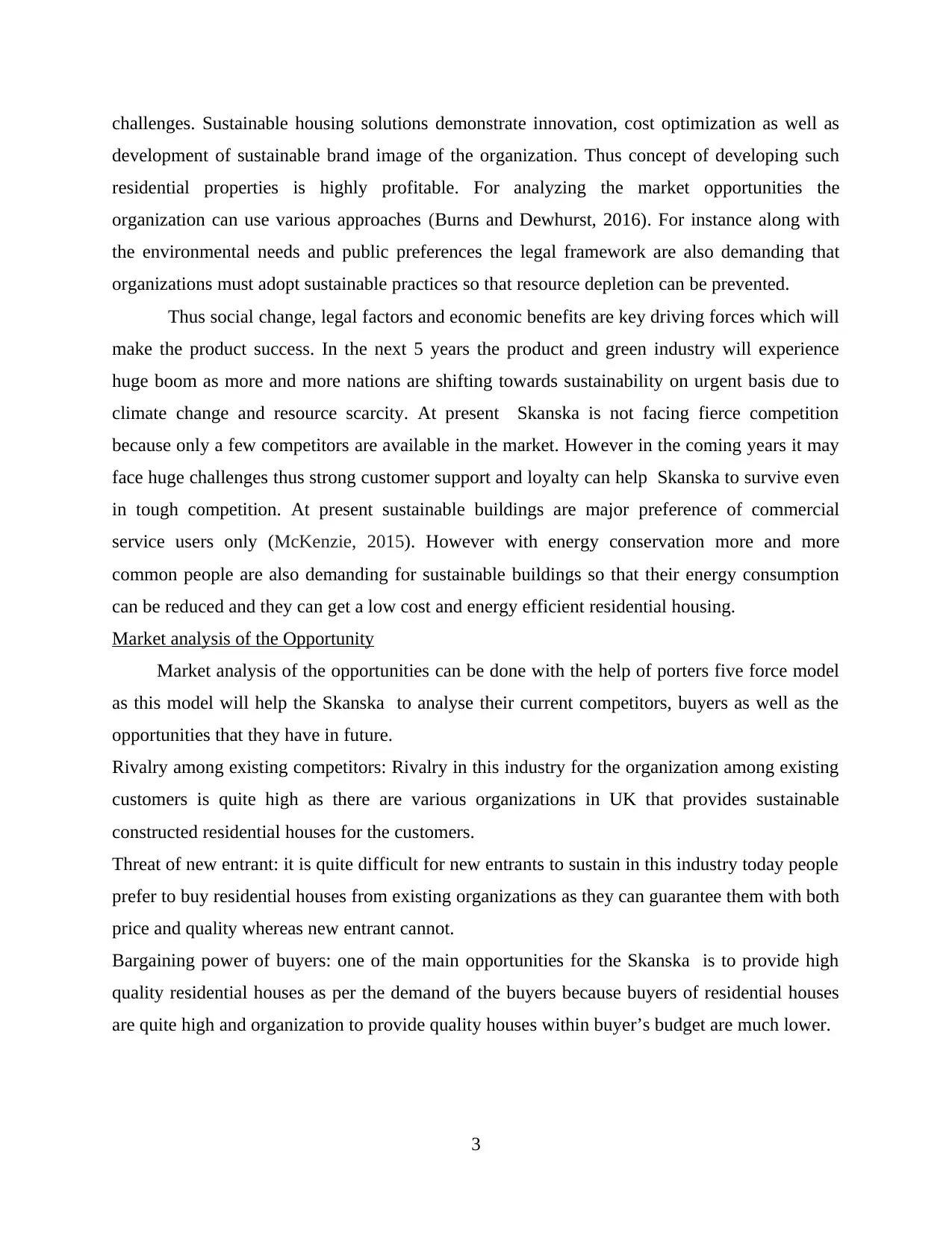
challenges. Sustainable housing solutions demonstrate innovation, cost optimization as well as
development of sustainable brand image of the organization. Thus concept of developing such
residential properties is highly profitable. For analyzing the market opportunities the
organization can use various approaches (Burns and Dewhurst, 2016). For instance along with
the environmental needs and public preferences the legal framework are also demanding that
organizations must adopt sustainable practices so that resource depletion can be prevented.
Thus social change, legal factors and economic benefits are key driving forces which will
make the product success. In the next 5 years the product and green industry will experience
huge boom as more and more nations are shifting towards sustainability on urgent basis due to
climate change and resource scarcity. At present Skanska is not facing fierce competition
because only a few competitors are available in the market. However in the coming years it may
face huge challenges thus strong customer support and loyalty can help Skanska to survive even
in tough competition. At present sustainable buildings are major preference of commercial
service users only (McKenzie, 2015). However with energy conservation more and more
common people are also demanding for sustainable buildings so that their energy consumption
can be reduced and they can get a low cost and energy efficient residential housing.
Market analysis of the Opportunity
Market analysis of the opportunities can be done with the help of porters five force model
as this model will help the Skanska to analyse their current competitors, buyers as well as the
opportunities that they have in future.
Rivalry among existing competitors: Rivalry in this industry for the organization among existing
customers is quite high as there are various organizations in UK that provides sustainable
constructed residential houses for the customers.
Threat of new entrant: it is quite difficult for new entrants to sustain in this industry today people
prefer to buy residential houses from existing organizations as they can guarantee them with both
price and quality whereas new entrant cannot.
Bargaining power of buyers: one of the main opportunities for the Skanska is to provide high
quality residential houses as per the demand of the buyers because buyers of residential houses
are quite high and organization to provide quality houses within buyer’s budget are much lower.
3
development of sustainable brand image of the organization. Thus concept of developing such
residential properties is highly profitable. For analyzing the market opportunities the
organization can use various approaches (Burns and Dewhurst, 2016). For instance along with
the environmental needs and public preferences the legal framework are also demanding that
organizations must adopt sustainable practices so that resource depletion can be prevented.
Thus social change, legal factors and economic benefits are key driving forces which will
make the product success. In the next 5 years the product and green industry will experience
huge boom as more and more nations are shifting towards sustainability on urgent basis due to
climate change and resource scarcity. At present Skanska is not facing fierce competition
because only a few competitors are available in the market. However in the coming years it may
face huge challenges thus strong customer support and loyalty can help Skanska to survive even
in tough competition. At present sustainable buildings are major preference of commercial
service users only (McKenzie, 2015). However with energy conservation more and more
common people are also demanding for sustainable buildings so that their energy consumption
can be reduced and they can get a low cost and energy efficient residential housing.
Market analysis of the Opportunity
Market analysis of the opportunities can be done with the help of porters five force model
as this model will help the Skanska to analyse their current competitors, buyers as well as the
opportunities that they have in future.
Rivalry among existing competitors: Rivalry in this industry for the organization among existing
customers is quite high as there are various organizations in UK that provides sustainable
constructed residential houses for the customers.
Threat of new entrant: it is quite difficult for new entrants to sustain in this industry today people
prefer to buy residential houses from existing organizations as they can guarantee them with both
price and quality whereas new entrant cannot.
Bargaining power of buyers: one of the main opportunities for the Skanska is to provide high
quality residential houses as per the demand of the buyers because buyers of residential houses
are quite high and organization to provide quality houses within buyer’s budget are much lower.
3
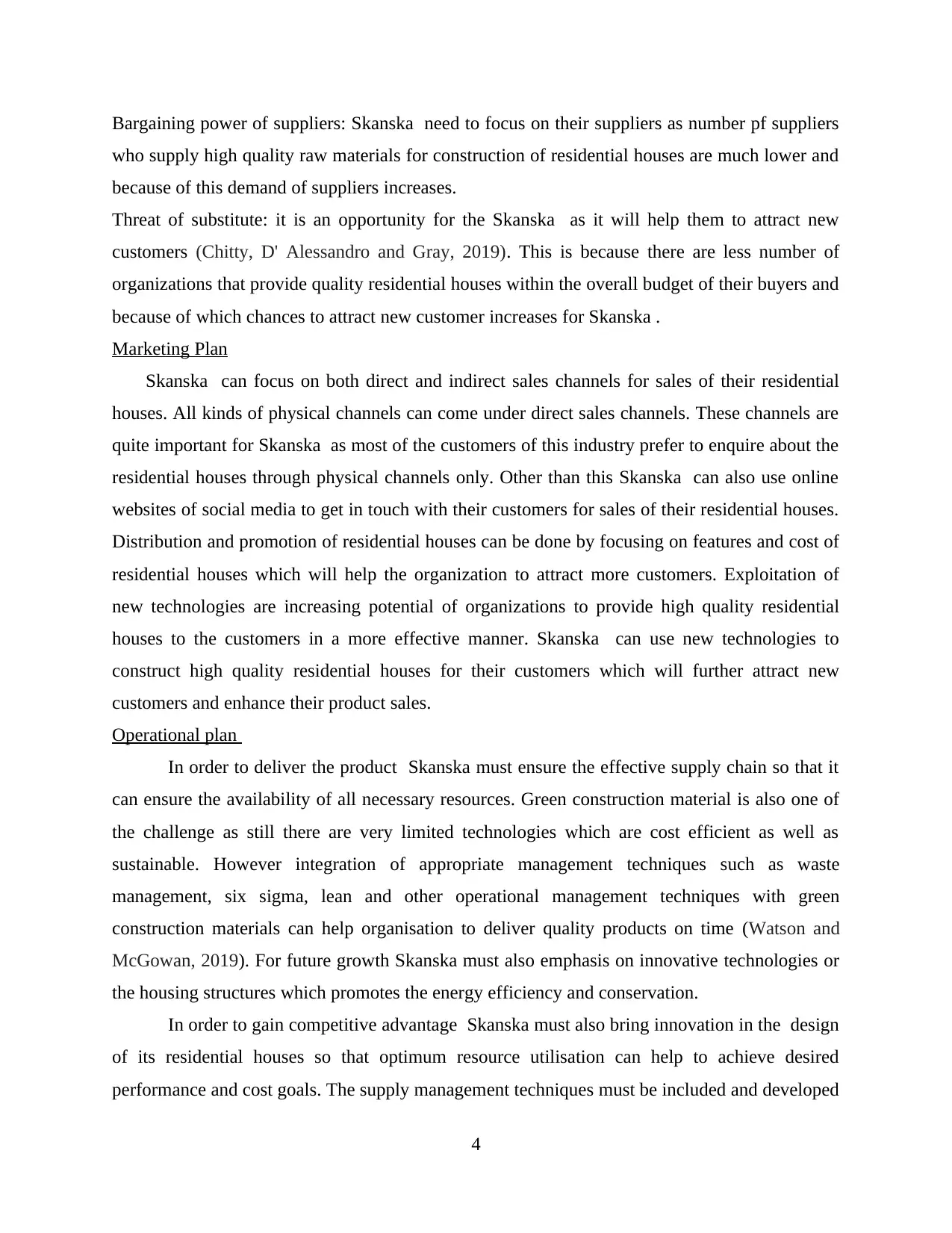
Bargaining power of suppliers: Skanska need to focus on their suppliers as number pf suppliers
who supply high quality raw materials for construction of residential houses are much lower and
because of this demand of suppliers increases.
Threat of substitute: it is an opportunity for the Skanska as it will help them to attract new
customers (Chitty, D' Alessandro and Gray, 2019). This is because there are less number of
organizations that provide quality residential houses within the overall budget of their buyers and
because of which chances to attract new customer increases for Skanska .
Marketing Plan
Skanska can focus on both direct and indirect sales channels for sales of their residential
houses. All kinds of physical channels can come under direct sales channels. These channels are
quite important for Skanska as most of the customers of this industry prefer to enquire about the
residential houses through physical channels only. Other than this Skanska can also use online
websites of social media to get in touch with their customers for sales of their residential houses.
Distribution and promotion of residential houses can be done by focusing on features and cost of
residential houses which will help the organization to attract more customers. Exploitation of
new technologies are increasing potential of organizations to provide high quality residential
houses to the customers in a more effective manner. Skanska can use new technologies to
construct high quality residential houses for their customers which will further attract new
customers and enhance their product sales.
Operational plan
In order to deliver the product Skanska must ensure the effective supply chain so that it
can ensure the availability of all necessary resources. Green construction material is also one of
the challenge as still there are very limited technologies which are cost efficient as well as
sustainable. However integration of appropriate management techniques such as waste
management, six sigma, lean and other operational management techniques with green
construction materials can help organisation to deliver quality products on time (Watson and
McGowan, 2019). For future growth Skanska must also emphasis on innovative technologies or
the housing structures which promotes the energy efficiency and conservation.
In order to gain competitive advantage Skanska must also bring innovation in the design
of its residential houses so that optimum resource utilisation can help to achieve desired
performance and cost goals. The supply management techniques must be included and developed
4
who supply high quality raw materials for construction of residential houses are much lower and
because of this demand of suppliers increases.
Threat of substitute: it is an opportunity for the Skanska as it will help them to attract new
customers (Chitty, D' Alessandro and Gray, 2019). This is because there are less number of
organizations that provide quality residential houses within the overall budget of their buyers and
because of which chances to attract new customer increases for Skanska .
Marketing Plan
Skanska can focus on both direct and indirect sales channels for sales of their residential
houses. All kinds of physical channels can come under direct sales channels. These channels are
quite important for Skanska as most of the customers of this industry prefer to enquire about the
residential houses through physical channels only. Other than this Skanska can also use online
websites of social media to get in touch with their customers for sales of their residential houses.
Distribution and promotion of residential houses can be done by focusing on features and cost of
residential houses which will help the organization to attract more customers. Exploitation of
new technologies are increasing potential of organizations to provide high quality residential
houses to the customers in a more effective manner. Skanska can use new technologies to
construct high quality residential houses for their customers which will further attract new
customers and enhance their product sales.
Operational plan
In order to deliver the product Skanska must ensure the effective supply chain so that it
can ensure the availability of all necessary resources. Green construction material is also one of
the challenge as still there are very limited technologies which are cost efficient as well as
sustainable. However integration of appropriate management techniques such as waste
management, six sigma, lean and other operational management techniques with green
construction materials can help organisation to deliver quality products on time (Watson and
McGowan, 2019). For future growth Skanska must also emphasis on innovative technologies or
the housing structures which promotes the energy efficiency and conservation.
In order to gain competitive advantage Skanska must also bring innovation in the design
of its residential houses so that optimum resource utilisation can help to achieve desired
performance and cost goals. The supply management techniques must be included and developed
4
⊘ This is a preview!⊘
Do you want full access?
Subscribe today to unlock all pages.

Trusted by 1+ million students worldwide
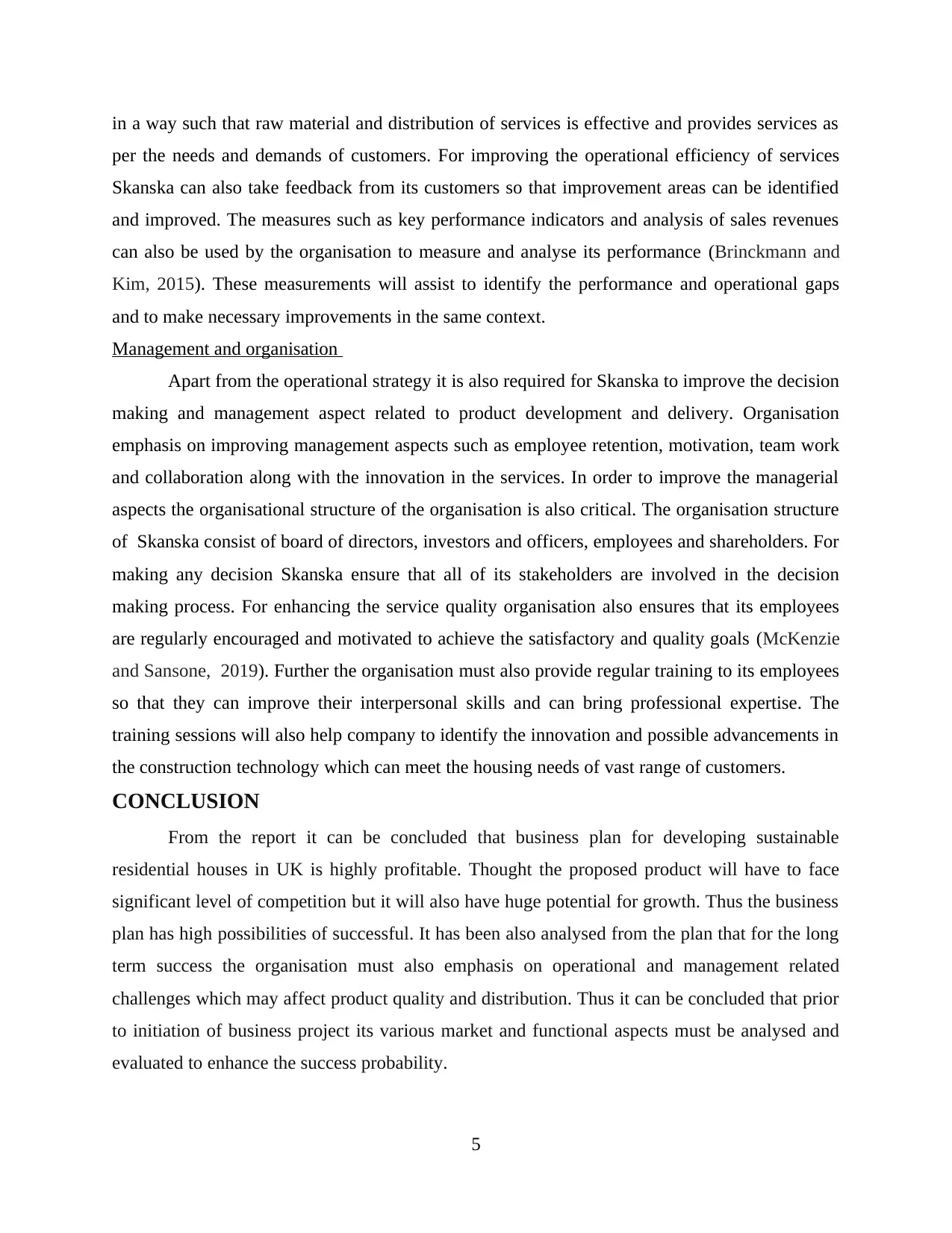
in a way such that raw material and distribution of services is effective and provides services as
per the needs and demands of customers. For improving the operational efficiency of services
Skanska can also take feedback from its customers so that improvement areas can be identified
and improved. The measures such as key performance indicators and analysis of sales revenues
can also be used by the organisation to measure and analyse its performance (Brinckmann and
Kim, 2015). These measurements will assist to identify the performance and operational gaps
and to make necessary improvements in the same context.
Management and organisation
Apart from the operational strategy it is also required for Skanska to improve the decision
making and management aspect related to product development and delivery. Organisation
emphasis on improving management aspects such as employee retention, motivation, team work
and collaboration along with the innovation in the services. In order to improve the managerial
aspects the organisational structure of the organisation is also critical. The organisation structure
of Skanska consist of board of directors, investors and officers, employees and shareholders. For
making any decision Skanska ensure that all of its stakeholders are involved in the decision
making process. For enhancing the service quality organisation also ensures that its employees
are regularly encouraged and motivated to achieve the satisfactory and quality goals (McKenzie
and Sansone, 2019). Further the organisation must also provide regular training to its employees
so that they can improve their interpersonal skills and can bring professional expertise. The
training sessions will also help company to identify the innovation and possible advancements in
the construction technology which can meet the housing needs of vast range of customers.
CONCLUSION
From the report it can be concluded that business plan for developing sustainable
residential houses in UK is highly profitable. Thought the proposed product will have to face
significant level of competition but it will also have huge potential for growth. Thus the business
plan has high possibilities of successful. It has been also analysed from the plan that for the long
term success the organisation must also emphasis on operational and management related
challenges which may affect product quality and distribution. Thus it can be concluded that prior
to initiation of business project its various market and functional aspects must be analysed and
evaluated to enhance the success probability.
5
per the needs and demands of customers. For improving the operational efficiency of services
Skanska can also take feedback from its customers so that improvement areas can be identified
and improved. The measures such as key performance indicators and analysis of sales revenues
can also be used by the organisation to measure and analyse its performance (Brinckmann and
Kim, 2015). These measurements will assist to identify the performance and operational gaps
and to make necessary improvements in the same context.
Management and organisation
Apart from the operational strategy it is also required for Skanska to improve the decision
making and management aspect related to product development and delivery. Organisation
emphasis on improving management aspects such as employee retention, motivation, team work
and collaboration along with the innovation in the services. In order to improve the managerial
aspects the organisational structure of the organisation is also critical. The organisation structure
of Skanska consist of board of directors, investors and officers, employees and shareholders. For
making any decision Skanska ensure that all of its stakeholders are involved in the decision
making process. For enhancing the service quality organisation also ensures that its employees
are regularly encouraged and motivated to achieve the satisfactory and quality goals (McKenzie
and Sansone, 2019). Further the organisation must also provide regular training to its employees
so that they can improve their interpersonal skills and can bring professional expertise. The
training sessions will also help company to identify the innovation and possible advancements in
the construction technology which can meet the housing needs of vast range of customers.
CONCLUSION
From the report it can be concluded that business plan for developing sustainable
residential houses in UK is highly profitable. Thought the proposed product will have to face
significant level of competition but it will also have huge potential for growth. Thus the business
plan has high possibilities of successful. It has been also analysed from the plan that for the long
term success the organisation must also emphasis on operational and management related
challenges which may affect product quality and distribution. Thus it can be concluded that prior
to initiation of business project its various market and functional aspects must be analysed and
evaluated to enhance the success probability.
5
Paraphrase This Document
Need a fresh take? Get an instant paraphrase of this document with our AI Paraphraser
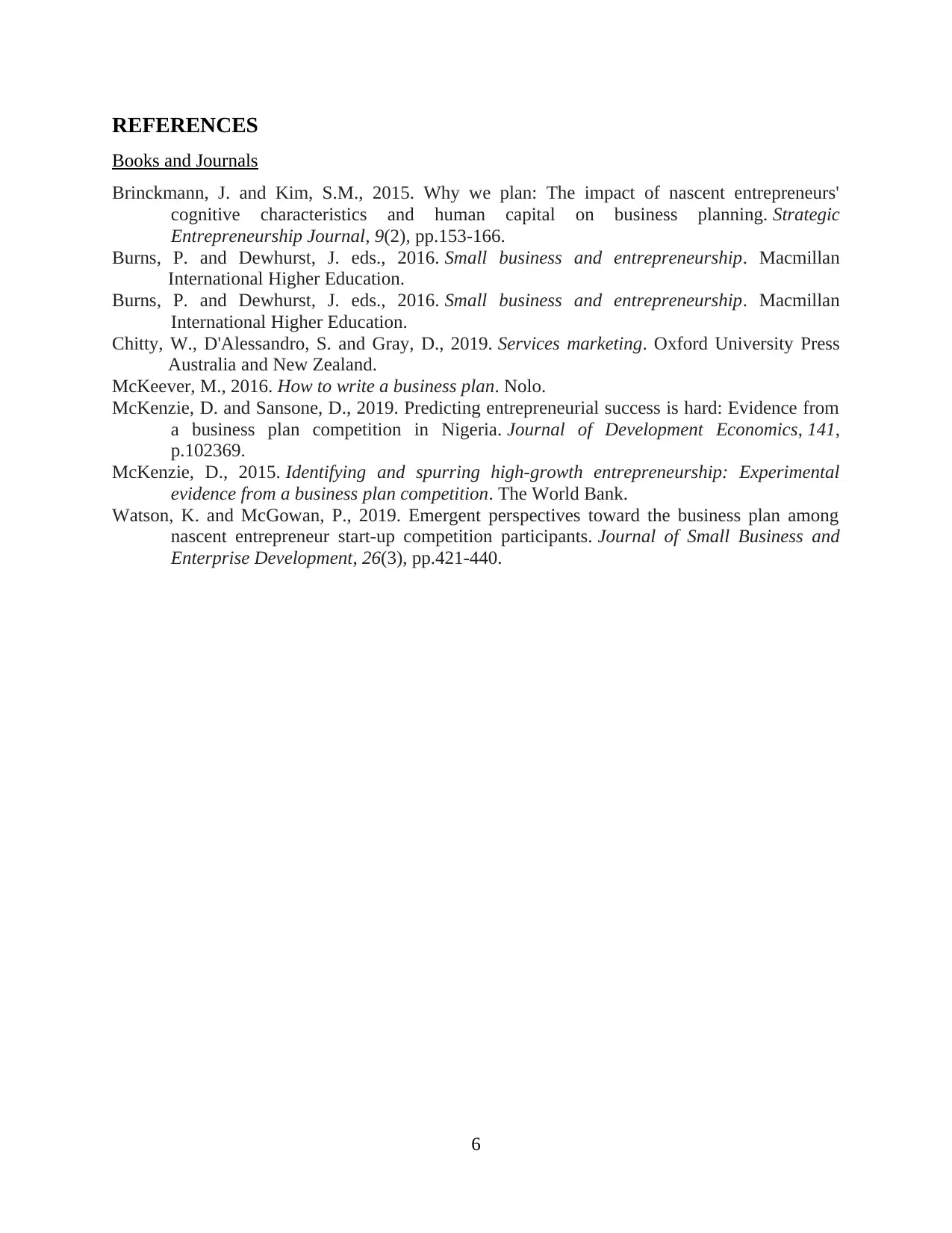
REFERENCES
Books and Journals
Brinckmann, J. and Kim, S.M., 2015. Why we plan: The impact of nascent entrepreneurs'
cognitive characteristics and human capital on business planning. Strategic
Entrepreneurship Journal, 9(2), pp.153-166.
Burns, P. and Dewhurst, J. eds., 2016. Small business and entrepreneurship. Macmillan
International Higher Education.
Burns, P. and Dewhurst, J. eds., 2016. Small business and entrepreneurship. Macmillan
International Higher Education.
Chitty, W., D'Alessandro, S. and Gray, D., 2019. Services marketing. Oxford University Press
Australia and New Zealand.
McKeever, M., 2016. How to write a business plan. Nolo.
McKenzie, D. and Sansone, D., 2019. Predicting entrepreneurial success is hard: Evidence from
a business plan competition in Nigeria. Journal of Development Economics, 141,
p.102369.
McKenzie, D., 2015. Identifying and spurring high-growth entrepreneurship: Experimental
evidence from a business plan competition. The World Bank.
Watson, K. and McGowan, P., 2019. Emergent perspectives toward the business plan among
nascent entrepreneur start-up competition participants. Journal of Small Business and
Enterprise Development, 26(3), pp.421-440.
6
Books and Journals
Brinckmann, J. and Kim, S.M., 2015. Why we plan: The impact of nascent entrepreneurs'
cognitive characteristics and human capital on business planning. Strategic
Entrepreneurship Journal, 9(2), pp.153-166.
Burns, P. and Dewhurst, J. eds., 2016. Small business and entrepreneurship. Macmillan
International Higher Education.
Burns, P. and Dewhurst, J. eds., 2016. Small business and entrepreneurship. Macmillan
International Higher Education.
Chitty, W., D'Alessandro, S. and Gray, D., 2019. Services marketing. Oxford University Press
Australia and New Zealand.
McKeever, M., 2016. How to write a business plan. Nolo.
McKenzie, D. and Sansone, D., 2019. Predicting entrepreneurial success is hard: Evidence from
a business plan competition in Nigeria. Journal of Development Economics, 141,
p.102369.
McKenzie, D., 2015. Identifying and spurring high-growth entrepreneurship: Experimental
evidence from a business plan competition. The World Bank.
Watson, K. and McGowan, P., 2019. Emergent perspectives toward the business plan among
nascent entrepreneur start-up competition participants. Journal of Small Business and
Enterprise Development, 26(3), pp.421-440.
6

REFERENCES
7
7
⊘ This is a preview!⊘
Do you want full access?
Subscribe today to unlock all pages.

Trusted by 1+ million students worldwide
1 out of 9
Related Documents
Your All-in-One AI-Powered Toolkit for Academic Success.
+13062052269
info@desklib.com
Available 24*7 on WhatsApp / Email
![[object Object]](/_next/static/media/star-bottom.7253800d.svg)
Unlock your academic potential
Copyright © 2020–2025 A2Z Services. All Rights Reserved. Developed and managed by ZUCOL.





